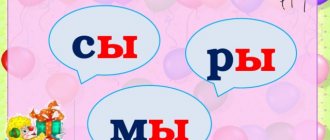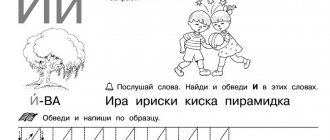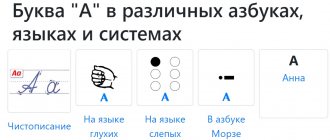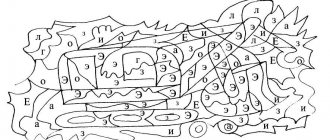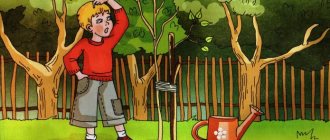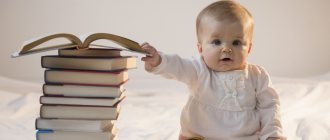Sound and letter T. Literacy lesson in the preparatory group
Municipal budgetary preschool educational institution "Kindergarten of general developmental type "Batyr" of the city of Buinsk, Buinsky municipal district of the Republic of Tatarstan"
Summary of
an open lesson on teaching literacy in the preparatory group “Sound and letter T”
Teacher of the first qualification category: Kashapova G.S.
2015 Goal: to consolidate the articulation and characteristics of the sound
“ T ”; develop phonemic hearing, attention and memory; practice sound-letter analysis and synthesis of words. Introduce the letter “ T ”, read the syllables.
Guys, today we will go on a journey through the “Land of Knowledge”. But first, let's remember what letters we already know? In order, name the letters and words you already know, in which this sound will come at the beginning. (A-watermelon, U-duck, O-glasses, M-mom, S-catfish, H-leb, R-crayfish, Sh-ball, Y-smoke, L-lemon, N-rhino, K-cat)
- Now tell me, into what groups are all the letters and sounds divided?
- (Vowels and consonants, hard and soft).
So, let's hit the road. Music (We're going, we're going...)
- The first stop is called "Sound"
- What sound is repeated in the words: cat, stomp, desk, cake (Sound “T”)
- Let's make the "T" sound
- What does our tongue do when we pronounce the sound “T” (knocks on the tubercles)
- Do you feel a stream of air rushing out?
- Let's try to sing the sound "T" (not sung)
- So what is the sound of "T"? (consonant)
Game "Passengers"
- You have pictures on the tables, they are rushing to catch the train, put them in the appropriate carriages: 1st carriage - the sound T at the beginning of the word;
2nd car - T sound in the middle of a word; 3rd car - T sound at the end of a word. Physical education session
We're a little tired, let's rest for a minute. Turn, tilt, jump, Smile, come on my friend, Keep your back straight, Look at your neighbor, Hands up and immediately down And get on the bus..
- We are traveling further through the land of knowledge. Music
Stop “Acquaintance with the letter T” I hang the letter “T” on the board.
- What elements does the sound T consist of? Let's make the letter “T” from sticks.
- What does he look like?
The hammer knocks: “Knock-Knock!” To the letter T I am an old friend. Finger gymnastics.
Fingers do exercises To get less tired And then they will write letters in a notebook Graphic dictation: 6 cells up, 2 cells to the left, 1 cell up, 5 cells to the right, 1 cell down, 2 cells to the left, 6 cells down, 1 cell to the left. Let's move on Music. Stop "Magic Clock". Educator. Read the syllables where the arrow stopped: at, ut, from, uat, ta, tu, then; Words: here, that, there, that, sweat, Tom. Game “Clever girls and smart guys” Pronouncing pure sayings: Ta-ta-ta - our house is clean. You-you-you - the cats ate all the sour cream. That's it - we started playing lotto. At-at-at- we take a scooter with us. Whoops, we're going for a walk. You guys are great! You had a great time today, and most importantly, it was useful.
- What sound were you introduced to in class?
- What does the letter look like?
The lesson is over
Lesson summary with presentation “Sound and letter T” Rezyapova Ksenia Aleksandrovna
author: Rezyapova Ksenia Aleksandrovna
teacher-speech therapist MBDOU "Kindergarten No. 1" Sarov
Lesson notes with presentation “Sound and letter T”
Topic:
“ Sound and the letter T”
Tasks:
- Reinforce the sounds and letters you have learned.
- Learn to highlight the “T” sound at the end of a word.
- Form the concepts of “vowel sound”, “consonant sound”, “letter”.
- Teach sound analysis and synthesis, reading syllables with studied letters.
- Build graphic skills.
- Develop phonemic awareness, auditory and visual attention, memory, thinking, general and fine motor skills.
Equipment:
presentation, cash register letters.
Progress of the lesson
1. Organizational moment.
Ask the children to name the sound by articulation. (“A-U-O-Y-E-I.”)
2. Exercise “What sound?”
- “A”, “O”, “U”, “I”, “E”, “Y” - what sounds are these? Why? (the air stream does not meet an obstacle (teeth, tongue, lips), sung)
- “M”, “P”, “T” - what sounds are these? Why? (the air stream meets an obstacle (teeth, tongue, lips), cannot be sung)
Characteristics of the T sound (consonant, voiceless, can be both hard and soft)
3. Exercise “How many sounds?”
- Listen: “AT” - how many sounds did I make? (2.)
- What's the first sound? What's the second sound? (Also syllables UT, OT, ET, IT, YT.)
4. Exercise “What will happen?”
Look at a couple of pictures of a duck - a bedside table. Invite children to identify the first sounds of words and put them together.
- The first is “U”, the second is “T”. What will happen? Etc. to form the syllables AT, OT, ET, IT.
5. Exercise “Repeat the phrase and choose a picture.”
Talk to the children in pure language (in chorus and individually) and ask them to choose a suitable picture.
- At-at-at - we eat salad.
- From-from-from - we drank compote.
- It-it-it - a whale is swimming in the sea.
- This-this-this - the lights were turned on in the house.
6. Exercise “Where is the sound “T?”
Using the pictures from the previous exercise, determine the position of the sound “T” in the words: salad, compote, whale, light.
7. Game “Repeat, don’t make a mistake.”
Invite the children to repeat the line of words, select the corresponding pictures and put them in the given order:
- Cat - whale - hippopotamus.
- Salad - robe - fireworks.
- Light - ticket - bow.
Ask questions:
— Tell me, where in the word “cat” (“whale”, “hippopotamus”, etc.) is the “T” sound heard?
- Physical education minute.
| From-from-from - the hippopotamus is walking. | Children walk slowly, waddle. |
| Oot-out-out - everyone swims together. | Imitates the movements of swimmers. |
| Ut-ut-ut - festive fireworks. | They imitate fireworks in the sky. |
| At-at-at - we're going to the parade. | Marching. |
9. Game "Well".
On a magnetic board, place cards with the letters A, U, O, I, E, Y in a column. Attach the card with the letter T to the picture with the image of a bucket. Lower the “bucket” into the “well” to the right of the letters. Read the received syllables.
10.Working with cash registers.
Invite the children to spell out the syllables AT, UT, IT, YT, ET, OT and read them.
11.Work in a notebook of speech therapy tasks.
Ask the children to type one syllable of each pattern.
Lesson summary with presentation “Sound and letter T” Rezyapova Ksenia Aleksandrovna
